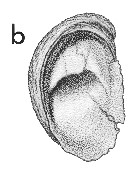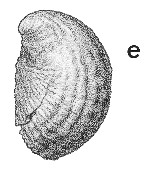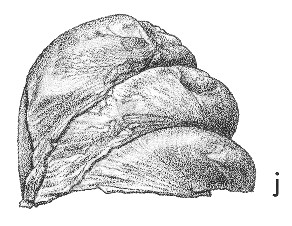
Revised descriptions of New Zealand Cenozoic Mollusca from Beu and Maxwell (1990)

 | Revised descriptions of New Zealand Cenozoic Mollusca from Beu and Maxwell (1990) | 
|
  (Pl. 14b): Grandicrepidula salebrosa, GS9517, I40/f9805, Campbell Park School, Otekaike, Waitaki Valley, Otekaike Limestone, Waitakian (GNS) |
  (Pl. 14e): Grandicrepidula salebrosa, GS9517, I40/f9805, Campbell Park School, Otekaike, Waitaki Valley, Otekaike Limestone, Waitakian (GNS) |
  (Pl. 29j): Maoricrypta radiata, Raurimu, Tongariro National Park, central North Island, Tongaporutuan, from a private collection (GNS; part of a spiral aggregation) |
Beu & Maxwell (1990): Chapter 13; p. 259; pl. 14 b,e; 29 j.
Synonymy: Crepidula incurva Zittel 1864, p. 44 (not of Broderip, 1834); Crypta striata Hutton 1873b, p. 14; Pilaeopsis radiatus Hutton 1873b, p. 14; Crepidula gregaria "Sowerby" of Suter 1914, p. 20 (not of Sowerby); Crepidula wilckensi Finlay 1924a, p. 101 (new name for C. incurva Zittel, preoccupied); Crypta opuraensis Bartrum and Powell 1928, p. 145; Crypta turnialis Bartrum and Powell 1928, p . 144; possibly also = Crepidula haliotoidea Marwick 1926c, p. 318; Maoricrypta striata; Crepidula radiata, Beu & Maxwell 1990, p. 259, pl. 14b, e; 29j.
Classification: Calyptraeidae
Description: Large for family (40-100 mm long), elongate limpet-shaped but with large horizontal internal septum (so, when inverted, shaped like a boat or slipper), long and moderately wide, with apex, or beak (at posterior end) straight or, in many specimens, weakly coiled to left (in dorsal view). Sculpture of longitudinal (strictly speaking, spiral) cords, exceedingly variable in prominence, from about 6 high, widely spaced, irregularly nodulous or serrate ribs of triangular section, to very many exceedingly fine, low, close threads, or no sculpture at all; at most localities smooth or weakly sculptured shells much more common than coarsely sculptured ones. Internal septum (widely extended columellar shelf) smooth, deeply set within shell, occupying posterior 0.3-0.5 of interior; its anterior margin simple, arcuate. A single relatively large muscle scar present in interior, alongside right side of base of septal insertion.
Comparison: Like all Calyptraeidae, Maoricypta radiata was a sedentary filter feeder. It lived attached to stones or other shells in the manner of a limpet, copying the substrate topography in its shape and waving of the margin, and so is highly variable in form. It occupied a large variety of hard substrates in shallow water (inner- to mid-shelf) environments.
This is one of the commonest and most ubiquitous and yet (taxonomically) one of the least well understood of New Zealand molluscan groups. The synonymy provided by Beu & Maxwell (1990) followed the conventional concept of Maoricrypta in New Zealand Cenozoic rocks — of relatively few (perhaps only one) very variable species with a long time range. However, Marshall (2003) began the re-analysis of this group by redescribing the Recent and some late Neogene species, assigning most to Maoricrypta (with a single muscle scar, on the right side of the septum) and a few to Grandicrepidula McLean, 1995 (with a muscle scar on each side of the septal insertion). Specimens aggregated in tall irregular to spiral stacks have been seen only from Tongaporutuan-Opoitian rocks (Tongaporutuan, widespread, including Hurupi Stream area, Palliser Bay, common, and Raurimu, central North Island (illustrated); Kapitean, East Cape and Awatere Valley; Opoitian, Waiouru area and Kaawa Creek, SW Auckland). In the modern American species Crepidula fornicata (Linne) such aggregations are protandrous sexual development series, with many large females making up most of the stack, small males at the summit, and individuals in between undergoing a change of gender. Although in the modern New Zealand species small male specimens are found on the shells of most large individual females, the formation of large stacks by Taranaki Series and Opoitian populations, only, indicates that these specimens (typical Maoricrypta radiata) are a distinct species from all the other forms included under this umbrella previously.
Beu & Maxwell (1990, p. 259) suggested that the lectotype (which they designated) of Crypta profunda Hutton (1873b, p. 14), Hutton's first-listed specimen from "Shakespeare Cliff, Wanganui" (actually from Tangahoe Formation at Waihi Beach, Hawera; in GNS) might be the species previously known in the Recent fauna as Maoricrypta youngi Powell. However, Marshall (2003) showed that, while M. youngi does occur fossil at Castlecliff (particularly in Upper Castlecliff Shellbed), the shells from Hawera are the real M. profunda. Therefore, the mid-Pliocene (Waipipian) to mid-Castlecliffian species that is similar to M. radiata in many characters but does not live in piles or stacks is identified as M. profunda. Its extinction in mid-Castlecliffian rocks at Wanganui is a useful biostratigraphic index. The real M. radiata is the stacking species limited to Late (and possibly Middle) Miocene to Opoitian rocks.
Also illustrated (Pl. 14 b,e) is Grandicrepidula salebrosa (Marwick, 1929), Duntroonian, Chatton, Southland (Duntroonian-Waitakian, Otago-South Canterbury) which, despite its similarity in shape and sculpture to Maoricrypta species, has a muscle scar on each side of the septal insertion and so belongs in Grandicrepidula.
Distribution: Clidenian-Wauauan?; Tongaporutuan-Opoitian. Awatere Valley, Marlborough; Upton Brook, Kapitean (holotype of Crepidula incurva Zittel, 1864, not of Broderip, 1834, = Crepidula wilckensi; and holotype of Crypta striata, the specimen figured by Zittel 1864, pl. 15, fig. 10); Awatere Valley, Marlborough, probably (as noted by Marwick 1948, p. 30) from concretions of "the Upton beds of Upton Brook" (Kapitean), a tributary of Awatere River (holotype of Pilaeopsis radiatus, with a fragment of Struthiolaria cincta in the matrix); Tirangi Stream, North Taranaki, in shallow facies with Struthiolaria callosa, etc., Tongaporutuan (holotype of Crepidula haliotoidea); Kaawa Creek, southwest Auckland, Opoitian, in shallow-water shellbeds (holotypes of both Crypta opuraensis and C. turnialis). The distinct genus and species Grandicrepidula salebrosa (Pl. 14b, e) occurs at Chatton, Southland, Duntroonian, in a shallow-water shellbed.
Cite this publication as: "A.G. Beu and J.I. Raine (2009). Revised
descriptions of New Zealand Cenozoic Mollusca from Beu and Maxwell (1990). GNS
Science miscellaneous series no. 27."
© GNS Science, 2009
ISBN
978-0-478-19705-1
ISSN 1177-2441
(Included with a PDF facsimile file
copy of New Zealand Geological Survey Paleontological Bulletin 58 in CD version
from: Publications Officer, GNS Science, P.O. Box 30368 Lower Hutt, New
Zealand)